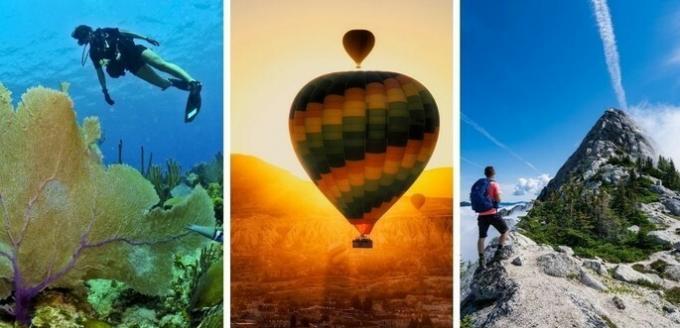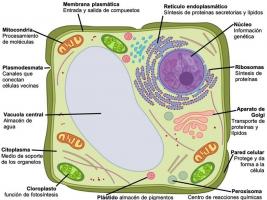13 types of tourism and their characteristics
Tourism is an activity that consists of moving to a place other than our place of residence. The purpose can be to rest, entertain ourselves or acquire knowledge.
There are several types of tourism depending on the place of destination, the reason for travel or the person who carries it out.
1. Medical tourism: health and wellness
It is a type of tourism that consists of traveling to receive medical treatment.
Medical tourism can be practiced for health reasons or for aesthetic reasons, to follow medication, therapy or undergo surgery.
Access to treatments that are not carried out in the country of residence, the reputation of the medical staff or the price, are some of the reasons that motivate this type of tourism.
2. Adventure tourism: sport and adrenaline

Adventure tourism is one in which activities that provide strong emotions, adrenaline and new experiences are carried out. The objective is to obtain sensations that contrast with what we see, do and feel in our daily lives.
Doing extreme sports, risky activities or visiting inhospitable places are some of the challenges that attract people who practice it.
3. Artistic tourism: culture and knowledge
Artistic tourism is one that seeks the acquisition of knowledge and sensations through the cultural heritage of the place being visited.
The attractions of this type of tourism are varied: paintings, archaeological sites, buildings, crafts, sacred precincts, sculptures or palaces are some examples.
Cultural tourism contributes to the maintenance and protection of artistic heritage, but its overcrowding can put the cultural essence and the space in which they take place at risk.
The sacred city of Machu Picchu (Peru) or the archaeological site of Stonehenge (England) are examples of cultural tourism destinations.
4. Language tourism: traveling to speak
It is a type of tourism focused on learning a new language. The tourist changes his place of residence, for a certain period of time, with the intention of learning a language other than his mother tongue.
The consumer of language tourism seeks a training offer that meets their expectations, as well as an environment geographical interest and other services, such as accommodation, transportation and activities to do in your time free.
The tourist attraction is, in addition to the language, the cultural heritage of the destination to which you travel.
5. Gastronomic tourism: delight of the senses
Gastronomic tourism is the one that is oriented to the knowledge of the culture of a place through its products and its cuisine.
It consists of traveling to other countries in search of new flavours, exotic foods of local origin, which offer the traveler a complete experience through the palate.
This type of tourism, in addition, allows knowing the processes of obtaining raw materials, their production, elaboration or cultivation.
The destinations are usually countries of great cultural diversity and mixture of traditions, places known for the production of world-famous products, or for carrying out exotic practices.
6. Religious tourism: a journey of faith

Bottom left: The Wailing Wall (Jerusalem). Bottom right: Cathedral of Santiago de Compostela (La Coruña).
It is the tourism destined to the visit of sacred precincts where to practice spirituality, in religious ceremonies or going on pilgrimage to places where miraculous events occurred.
These places are visited by multitudes of people to pray or express their gratitude to the saint they are devoted to.
It is considered the oldest type of tourism, because in many past cultures, the faithful traveled to the sacred precincts to honor their deities.
The Basilica of San Pedro and the Vatican, in Rome (Italy) or the Basilica of Santa María de Guadalupe (Mexico) are examples of places of a religious nature.
7. Ecotourism: know and protect

Ecotourism, or ecological tourism, is a type of tourism that takes place in contact with nature.
It is a sustainable tourism in which recreational activities are carried out aimed at raising awareness, protection and conservation of the environment.
The hope of generating economic benefits that allow protecting the areas in which it is practiced is what promotes it.
Some of the most common practices are the observation of fauna and flora or astronomical observation.
8. Luxury tourism: exclusive and elitist
Luxury tourism is one that seeks personalized and exclusive experiences that are not accessible to most due to their exorbitant price. It is aimed at people with high purchasing power and the consumption of superior category products and services.
It is possible to enjoy luxury in many ways such as cruises or safaris, in the luxurious hotels or visiting cities known for their boutiques and shopping avenues.
9. Business tourism: obligation and devotion
It is a kind of tourism that consists of moving to other places for professional reasons. The celebration of congresses, fairs, presentations and conventions are the backbone of business tourism.
The destination is not chosen by the tourist, but by the entity that organizes the trip and their leisure time is usually limited by the schedules and activities of the event.
Business tourism contributes to the economic balance of the sector throughout the year, by holding these events during low season periods.
10. Rural tourism: tranquility and tradition
It is a type of tourism that takes place in geographical areas characterized by having few inhabitants and a large natural environment.
This type of tourism offers the possibility of discovering daily life in rural areas through activities that promote respect and awareness of the environment and its traditions.
Some of the activities provided by rural destinations are organic farming, craft classes, local cooking courses or routes that we can take on foot or by bicycle.
11. Solidarity tourism: a cause to travel

It is a tourism alternative focused on cooperation and humanitarian aid in places that are still developing or recovering.
The objectives are multiple: to help economic growth, to preserve the environment and culture, to improve education and health, to reduce social inequality, etc.
The tourist, in addition to knowing the place, obtains an enriching experience and personal growth helping those who need it most.
Helping in schools and hospitals, reforestation programs, crop maintenance or animal rescue are some of the tasks in which collaboration is required.
12. Space tourism: straight to the stars
Space tourism is an activity in which travel is carried out at more than 100 km above sea level. These flights must be recreational in nature and cross the line that separates our atmosphere from outer space.
It is a type of tourism considered luxury because only people with high purchasing power can afford this unique experience, whose value can reach figures of several million dollars.
This activity is dangerous and demanding, since it requires adequate physical conditions. Tourists must undergo prior preparation in theoretical and practical aspects before carrying out the space flight.
Space tourism is not very sustainable due to the emissions generated by spacecraft fuels, which contribute to the heating and destruction of ozone particles in the atmosphere.
There are two types of spaceflight:
- Orbital space flight, which maintains a trajectory and speed sufficient to allow it to go around the Earth.
- Suborbital space flight, which reaches through the atmosphere, but without sufficient speed to allow it to orbit.
13. Virtual tourism: traveling to another reality
Virtual tourism is a tool that allows us to visit cities, monuments or museums without having to travel to the place where they are.
It consists of a recreation through digital technology, in order to simulate the experience in a interactive, thanks to high-quality photographs and videos that allow a 360º visualization of the place.
Applications such as Google Earth or Google Street View allow us to make modest virtual visits to any part of the world from our home.
The agencies specialized in this type of tourism have more advanced devices, such as 3D viewing glasses, which guarantee the traveler a high-quality interaction.
This technology makes it possible to visit a place at any time in history, so that it is possible to discover sites and monuments that have not survived the passage of time.
Virtual tourism does not attend to limitations such as the weather or overcrowding. In addition, it is an alternative for people who, due to physical limitations, cannot carry out a tourist activity normally.
References:
- Fairweather Balmaseda, J. (2021). Evolution of luxury tourism: Transport and accommodation.
- Gonzalez, M. TO. P. (2019). Suborbital space tourism: basic concepts. Science and Sea, 23(69), 35-44.
- Ledhesma, M. (2018). Types of tourism: new classification. Buenos Aires, 1..

